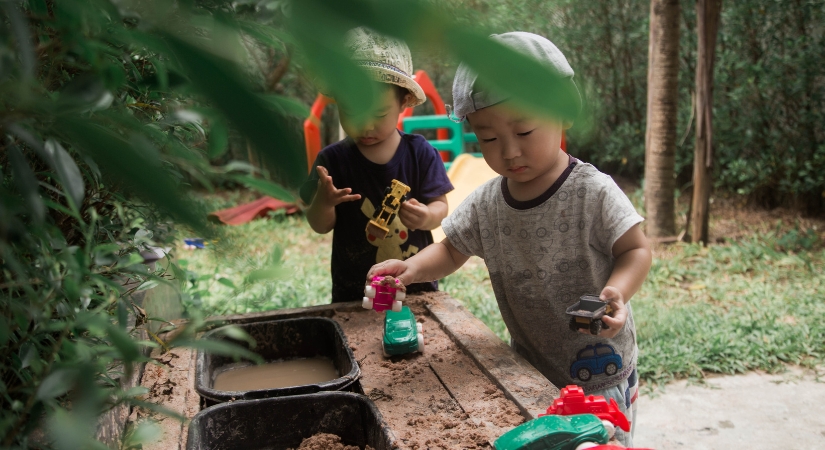Nature is all around us, from the trees swaying in the wind to the birds chirping in the sky. Being involved in nature can have a huge impact on Early Years development.
Getting young children outdoors provides opportunities for sensory exploration, physical development, and emotional well-being. Spending time in nature can help children feel calm, build curiosity, and encourage independence. In this blog, we explore 5 nature-based activities designed to support early development while fostering a connection with the natural world.
1. Nature Scavenger Hunt
A fun and engaging activity that encourages children to explore their surroundings and discover the natural world.
Materials:
- Small baskets or paper bags
- A simple checklist with images of items to find (leaves, sticks, rocks, flowers, etc.)
How to:
- Prepare a short list of natural items children might find in your outdoor space.
- Give each child a basket and the checklist.
- Guide them around the area, helping them find and collect the items.
Benefits:
- Boosts observation skills: Encourages attention to detail and visual discrimination as children look closely at their environment to find listed items.
- Supports vocabulary development: Learning the names of different natural items and describing their findings helps build expressive language and comprehension.
- Promotes physical movement: Walking, bending, and picking up objects encourages coordination and supports gross motor development.
2. Mud Kitchen Play
A sensory-rich, imaginative activity that allows children to experiment and create using natural materials.
Materials:
- Old pots, pans, and spoons
- Access to soil and water
- Containers for mixing
How to:
- Set up a mud kitchen area with tools and ingredients.
- Encourage children to create “recipes” with mud, leaves, and other natural materials.
- Let them explore freely while narrating their play.
Benefits:
- Enhances creativity and imagination: Children engage in pretend play, inventing stories and scenarios that develop their creative thinking.
- Improves fine motor skills: Scooping, pouring, and stirring strengthen hand and finger muscles, preparing children for writing and self-care tasks.
- Provides sensory stimulation: Handling mud, water, and natural textures helps develop the sensory system and encourages comfort with different tactile experiences.
3. Leaf and Bark Rubbing
This simple yet rewarding activity introduces children to texture and pattern through direct interaction with natural materials.
Materials:
- Paper
- Crayons or chalk
- A variety of leaves and tree trunks
How to:
- Place paper over a leaf or tree bark.
- Rub a crayon gently across the surface.
- Compare textures and patterns.
Benefits:
- Builds sensory awareness: Children begin to notice and appreciate different textures found in nature, enhancing their sensory processing.
- Develops hand control: The fine motor effort needed to hold paper and apply consistent crayon pressure supports pencil grip and control.
- Supports focus and concentration: Completing rubbings requires attention to detail and sustained effort, helping improve attention span.
4. Bug Hotel Building
A hands-on project that encourages children to care for the environment and observe small creatures in their natural habitats.
Materials:
- Small wooden box or crate
- Natural materials (twigs, pinecones, leaves, bark)
- A safe outdoor area to place the hotel
How to:
- Fill a box with different natural materials to create hiding spots for insects.
- Place the box in a quiet, shaded outdoor area.
- Observe and discuss any bugs that move in over time.
Benefits:
- Encourages respect for living things: Caring for and observing small creatures helps children develop empathy and environmental awareness.
- Supports scientific thinking: Watching which bugs arrive and asking questions about their behaviour nurtures curiosity and early investigation skills.
- Improves patience and attention: Waiting for bugs to appear and focusing on small details helps build patience and careful observation.
5. Cloud Watching and Nature Sounds
A calming and reflective activity that invites children to slow down, look up, and listen to the world around them.
Materials:
- Picnic blankets or mats
- Access to an open sky or quiet natural setting
How to:
- Lie on blankets outdoors and look up at the sky.
- Encourage children to describe the clouds or what they see.
- Pause to listen for birds, rustling leaves, or distant sounds.
Benefits:
- Promotes mindfulness and relaxation: This calming activity helps regulate emotions, reduce stress, and foster a peaceful state of mind.
- Develops listening skills: Paying attention to natural sounds hones auditory discrimination, which is key for language and communication development.
- Fosters imagination: Identifying shapes in clouds and making up stories builds creativity and abstract thinking.
Final Thoughts
Bringing nature into Early Years settings doesn’t require elaborate equipment or perfect weather. With a little creativity and a willingness to explore, practitioners can open a world of wonder for young children that supports every area of their development.
Exploring nature with young children offers countless opportunities for development, curiosity, and calm. With the right tools, you can easily plan, document, and share these meaningful moments with families. eyworks makes it simple to capture and communicate the magic of outdoor learning – book a free demo to see how our software can support your setting.
